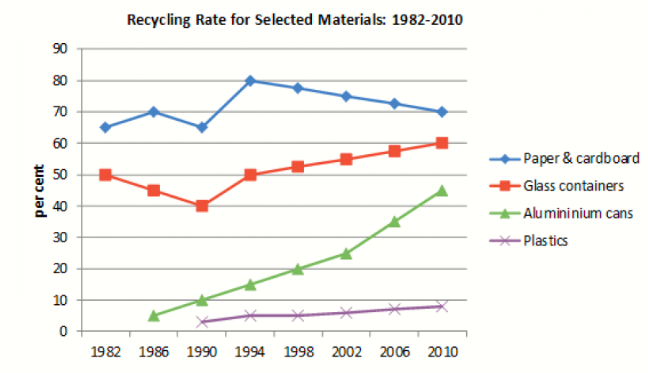The graph illustrates a significant transformation in the recycling rates of four materials (aluminum cans, paper, glass, and plastic) within a specific country over a period of 28 years, from 1982 to 2010.
A striking trend emerges in the recycling rate of aluminum cans. Virtually non-existent in 1982, it exhibits a remarkable surge, exceeding 40% by 2010. This rapid rise coincides with the apparent introduction of aluminum cans around 1986. Interestingly, this period also witnessed a moderate decline of around 10% in the recycling rates of paper and glass containers.
However, the trends for paper and glass diverge thereafter. Paper and cardboard recycling displays a gradual decrease, falling from 80% in 1994 to 70% in 2010. Conversely, glass containers show a positive trajectory, with their recycling rate climbing from 50% to 60% during the same timeframe. Notably, the recycling rate for plastics remains relatively stagnant, showing minimal growth over the decades.
The graph’s pronounced shifts suggest a growing focus on recycling materials with higher economic value, such as glass and aluminum. This phenomenon can be attributed to several factors. Advancements in production efficiency likely led to increased disposable income, allowing consumers to purchase more beverages in aluminum and glass packaging. As a result, the focus for industries might have shifted towards cost reduction and profit maximization. In this context, improving the recycling rate of valuable materials like aluminum and glass might have been seen as a more readily achievable solution.
In conclusion, the period between 1982 and 2010 witnessed a gradual shift in the market share of different packaging materials. The rise of aluminum cans and glass containers seemingly coincided with a decline in the use of paper, cardboard, and plastics. This trend is further reflected in the changing recycling rates for these materials, with a growing emphasis on the more valuable aluminum and glass.






 Đăng ký
Đăng ký 

Mình quên chỉnh lại score, mình nghĩ 4.0-5.0